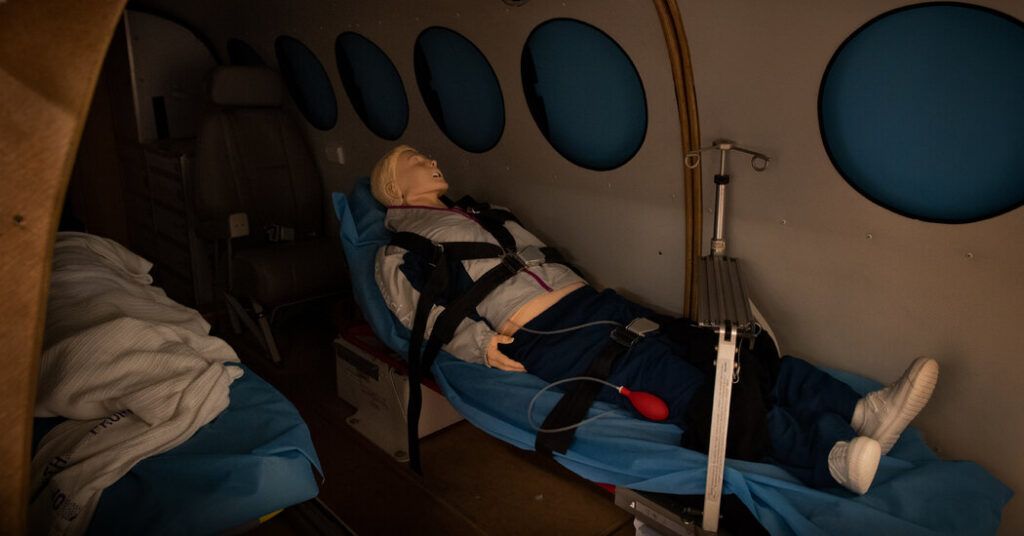The Australia Letter is a weekly newsletter from our Australia bureau. This week’s issue is written by Julia Bergin, a reporter based in the Northern Territory.
No drugs, no tools, no team: These are the work conditions for a remote Australian doctor.
And when that is the case, when doctors have no stocked pharmacy, no operating theater, and no extra hands to call on, their job becomes less medicine and more logistics.
Dr. Rhys Harding, a remote general practitioner, said his daily work involves asking questions that his peers in big cities never need to think about: “What have I got? Who’s here? What time is it getting dark? Can the plane land?”
Next comes a long list of medical skills that he needs, such as handling complex head injuries, taking X-rays and extracting teeth.
“I’m far more comfortable in a mouth than most doctors would be,” Dr. Harding said.
For Australian doctors who work in the country’s most remote locations, practicing medicine can be limitless, limiting, isolating and exceptionally challenging. The environment is harsh, and the physical and mental demands on the doctors, who are often deployed on their own, are more extreme than in any metropolitan hospital setting.
Dr. Michael Clements, a vice president of the Royal Australian College of General Practitioners, says it’s got less to do with remoteness and more to do with resources.
“We can do a lot with just our hands, but generally speaking we like to have our drugs, we like to have our toys, we like to have our team,” said Dr. Clements, who spent 13 years as a doctor in the Australian Air Force traveling to places like Afghanistan, Djibouti and Somalia.
Dr. Clements, now based in the east Queensland town of Townsville, operates as a fly-in-fly-out doctor for remote communities in Queensland, Northern Territory and Western Australia. These places, he says, are more medically challenging than most of the war zones he visited.
“In the military, we had access to surgeons and CT scanners and anaesthetists and orthopedic surgeons and lots of people to help,” Dr. Clements said, adding that a soldier with so much as a “tickle in their throat” would be tended to immediately.
That’s very different from remote medicine within Australia, where scant resources mean patients might have to wait weeks for an assessment, a prescription or an X-ray.
Communications are also a challenge, Dr. Clements added, with patchy cellphone reception and internet in remote parts of Australia making it hard for doctors to seek a second opinion. Instead, they rely heavily on what he terms the “friend network.”
That means finding a friend or acquaintance who works at a local hospital and establishing a referral or linkup service.
“In the Middle East, it didn’t matter if I was in the middle of nowhere in a desert, I could easily phone back to Australian colleagues and non-GP specialists,” Dr. Clements said.
Dr. Harding spent 18 months as the sole doctor at Australia’s base in Antarctica. He had, he said, “all the medications in the world,” plenty of instruments, an operating theater and even a dental chair. Despite the extreme isolation of the South Pole, he said it was easier to work as a doctor there than in remote Australia.
But Antarctica also poses unique challenges, such as the possibility of needing to practice medicine on oneself. In order to avoid this, Australian doctors deployed to Antarctica, for example, are required to have their appendixes removed.
Dr. Jeff Ayton, the chief medical officer of the Australian Antarctic Division, said that the policy was imposed after a treacherous evacuation in the 1950s of an Australian doctor with acute appendicitis requiring emergency surgery.
A decade later, a Russian doctor on an Antarctic mission who also contracted appendicitis enlisted a fellow expeditioner to hold up a mirror and proceeded to operate on himself, using only local anesthesia. There have also been cases of self-diagnosis and treatment of heart attacks and self-removal of breast lumps.
To forestall some medical emergencies, doctors may have to undergo other pre-emptive procedures to qualify for deployment. Wisdom teeth that could present a problem down the road must come out. A changing heart valve, which doctors would normally monitor, requires surgery. Under normal circumstances, the gall bladder wouldn’t be removed, but for a doctor in a remote setting — whether on an Antarctic or military deployment — it could be a preventative prerequisite.
Despite the many hurdles, threats and risks for remote doctors, Dr. Harding says the challenges make the job appealing.
And, he added, the setting makes him immune from the single most arduous part of the hospital system — its layer-upon-layer of hierarchical decision-making.
Dr. Harding compared it to someone having a broken hand visiting an emergency department, then being referred to an orthopedic doctor — who might say, “Oh, no, we just do the wrist” — and then on to a plastic surgeon — who says, “Where’s your boss, why can’t you deal with this?” — before being sent back to emergency.
Instead, Dr. Harding says each decision is his and his alone when working remotely.
“It’s quite liberating to be like, ‘I’m the best person here for the job’,” he said.
Now here are this week’s stories.
Are you enjoying our Australia bureau dispatches?
Tell us what you think at NYTAustralia@nytimes.com.
Like this email?
Forward it to your friends (they could use a little fresh perspective, right?) and let them know they can sign up here.


